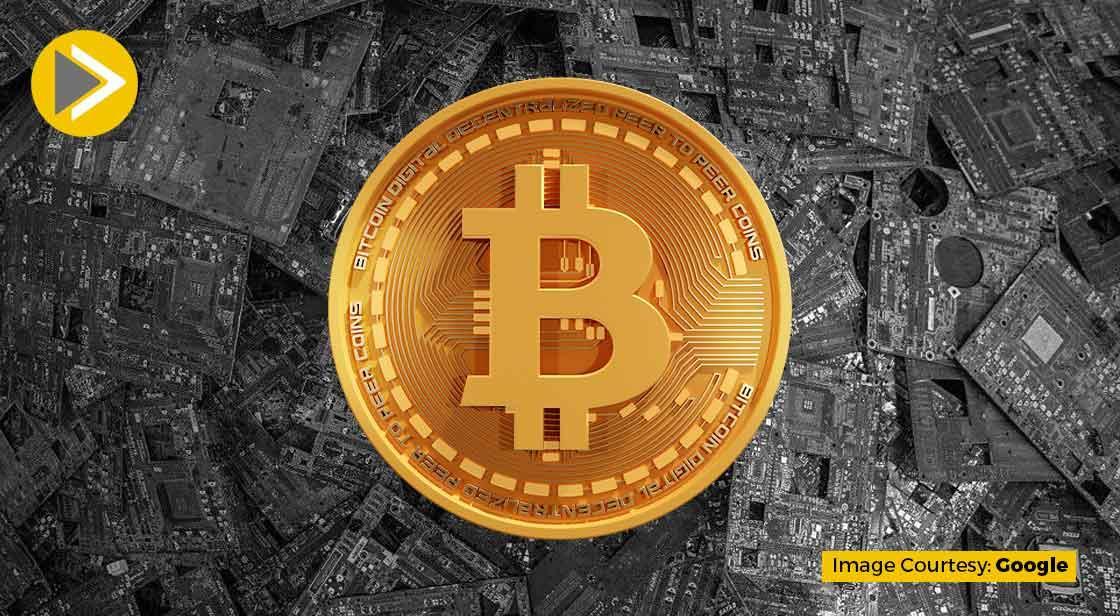Bitcoin Sets New Record as Institutional Backing Grows

News Synopsis
Bitcoin soared to an all-time high on Wednesday, surpassing its previous peak from January, amid improving global investor sentiment and a shift in market dynamics. The cryptocurrency touched an intraday high of $109,760.08, and was last seen trading 1.1% higher at $108,117.
This rally comes in the wake of easing trade frictions between the U.S. and China and recent macroeconomic developments that have prompted a flight to alternative assets, especially in the cryptocurrency space.
Global Developments Fuel Bitcoin’s Climb
The latest rise in bitcoin’s value follows a mix of macroeconomic events:
-
Moody’s downgrade of U.S. sovereign debt has spurred investors to diversify their portfolios away from the U.S. dollar.
-
Reduced U.S.-China trade tensions have helped improve global risk appetite.
“Now that January’s high has been surpassed – and the 50 percent upside from April’s lows has been achieved – bitcoin enters blue sky territory with tailwinds in the form of institutional momentum and a favorable U.S. regulatory environment,” said Antoni Trenchev, co-founder of digital asset trading platform Nexo.
Nasdaq Surge and Dollar Weakness Add Momentum
Bitcoin’s price trajectory appears to be mirroring other high-growth assets such as tech stocks, with the Nasdaq Composite Index rising 30% since early April.
-
The continued weakness of the U.S. dollar has added further strength to bitcoin’s rally.
-
Institutional interest is also driving the surge, with major financial players now entering the crypto space.
Institutional Support Grows
This week, crypto enthusiasts pointed to signs of growing mainstream acceptance:
-
JPMorgan CEO Jamie Dimon, previously a vocal critic of cryptocurrencies, confirmed the bank will allow clients to buy bitcoin.
-
Coinbase, the leading U.S. crypto exchange, was recently added to the S&P 500 index.
-
However, the company also disclosed that the U.S. Department of Justice has launched a probe into a recent data breach.
What Lies Ahead for Bitcoin?
“We’re still in year four of the bitcoin price cycle – the year after the bitcoin halving when miner rewards are slashed in half – which historically means its best days are still ahead of it and – while macro uncertainty and the threat of further volatility remains, a target of $150,000 in 2025 is still very much on the cards,” Trenchev noted.
Ether Trails Behind
In contrast to bitcoin’s record-setting run, Ether, the second-largest cryptocurrency, has not followed suit. It was last down 0.5% at $2,513, despite the upbeat sentiment in the broader crypto market.
History of Bitcoin
The history of Bitcoin is a fascinating journey from an academic concept to a global financial phenomenon. It's marked by a mysterious creator, groundbreaking technology, and a volatile yet upward price trajectory.
The Genesis of Bitcoin (2008-2009):
-
Satoshi Nakamoto: Bitcoin was invented by an anonymous entity known as Satoshi Nakamoto. To this day, the true identity of Satoshi Nakamoto (whether an individual or a group) remains unknown, adding to the mystique of Bitcoin.
-
Whitepaper Publication (October 31, 2008): Amidst the 2008 global financial crisis, a link to a whitepaper titled "Bitcoin: A Peer-to-Peer Electronic Cash System" authored by Satoshi Nakamoto was posted to a cryptography mailing list. This nine-page paper laid out the fundamental principles of Bitcoin, proposing a decentralized digital currency that would allow online payments to be sent directly from one party to another without going through a financial institution. This was a revolutionary solution to the "double-spending problem" for digital currency using a novel technology: the blockchain.
-
Genesis Block (January 3, 2009): The Bitcoin network was officially created when Satoshi Nakamoto mined the genesis block (Block 0) of the Bitcoin blockchain. Embedded in this block was the text "The Times 03/Jan/2009 Chancellor on brink of second bailout for banks," often interpreted as both a timestamp and a commentary on the traditional financial system's instability.
-
First Transaction (January 12, 2009): Nine days later, the first Bitcoin transaction occurred when Satoshi Nakamoto sent 10 Bitcoins to cryptographer Hal Finney, an early supporter and developer.
Early Development and Adoption of Bitcoin(2010-2012):
-
First Real-World Transaction (May 22, 2010): The famous "Bitcoin Pizza Day" occurred when programmer Laszlo Hanyecz bought two Papa John's pizzas for 10,000 Bitcoins. This marked Bitcoin's first real-world value, though at the time, 10,000 BTC were worth less than a penny each. This day is celebrated annually as "Bitcoin Pizza Day."
-
Early Exchanges: The first Bitcoin exchange, New Liberty Standard Exchange, set Bitcoin's first recorded price at $0.00099/BTC in October 2009.
-
Satoshi's Disappearance (Late 2010): Satoshi Nakamoto gradually withdrew from public involvement in Bitcoin's development, handing over the network alert key and control of the code repository to Gavin Andresen, who became a lead developer.
-
Bitcoin Price Milestones:
-
February 2011: Bitcoin reached $1.00 for the first time.
-
June 2011: The price surged to nearly $30 before a sharp correction.
-
-
Bitcoin Foundation (2012): Formed to promote and standardize Bitcoin.
-
First Halving (November 2012): Bitcoin underwent its first "halving" event, where the reward for mining new blocks was cut in half (from 50 BTC to 25 BTC). This built-in scarcity mechanism is crucial to Bitcoin's long-term value proposition.
Mainstream Awareness and Volatility (2013-2016):
-
Price Surges: Bitcoin experienced significant price increases, crossing $100 and then $1,000 for the first time in late 2013. This attracted considerable media attention.
-
Mt. Gox Collapse (2014): The collapse of Mt. Gox, once the largest Bitcoin exchange, due to security breaches and theft of hundreds of thousands of Bitcoins, caused a major setback for Bitcoin's reputation and led to a significant price decline.
-
Regulatory Scrutiny: As Bitcoin's popularity grew, regulators worldwide began to examine its implications, leading to varying stances on its legality and use.
-
Blockchain Innovation: Despite volatility, the underlying blockchain technology gained increasing recognition for its potential beyond just cryptocurrency.
Institutional Adoption and All-Time Highs (2017-Present):
-
2017 Bull Run: Bitcoin saw an unprecedented bull run, soaring from under $1,000 at the beginning of the year to nearly $20,000 by December. This brought cryptocurrencies into the mainstream consciousness.
-
Scaling Debates: Discussions and debates around Bitcoin's scalability led to the development of solutions like the Lightning Network and some contentious "forks" (e.g., Bitcoin Cash).
-
Institutional Interest: In later years, major corporations and financial institutions began showing increasing interest in Bitcoin, some adding it to their balance sheets (e.g., MicroStrategy, Tesla).
-
2020-2021 Surges: Following the COVID-19 pandemic and increased liquidity, Bitcoin experienced another massive surge, reaching new all-time highs of over $60,000 in April 2021 and close to $69,000 in November 2021.
-
Bear Markets (2022): 2022 saw a significant bear market, with Bitcoin's price falling significantly due to macroeconomic factors (inflation, interest rate hikes) and major crypto industry events (e.g., Luna/Terra collapse, FTX bankruptcy).
-
Spot Bitcoin ETFs (January 2024): A monumental moment for Bitcoin adoption occurred when the U.S. Securities and Exchange Commission (SEC) approved several spot Bitcoin Exchange-Traded Funds (ETFs). This allowed traditional investors to gain exposure to Bitcoin through regulated financial products, leading to substantial inflows of capital.
-
New All-Time Highs (2024): Fueled by the ETF approvals and the fourth Bitcoin halving in April 2024, Bitcoin reached new all-time highs, surpassing $73,000 in March 2024 and continuing to see strong investor interest. As of May 2025, it has seen further significant gains.
Bitcoin's history is a testament to its resilience and the powerful idea of decentralized digital money. Despite its volatility and the ongoing debates surrounding its regulation and environmental impact, it has fundamentally challenged traditional financial systems and continues to evolve as a significant global asset.









